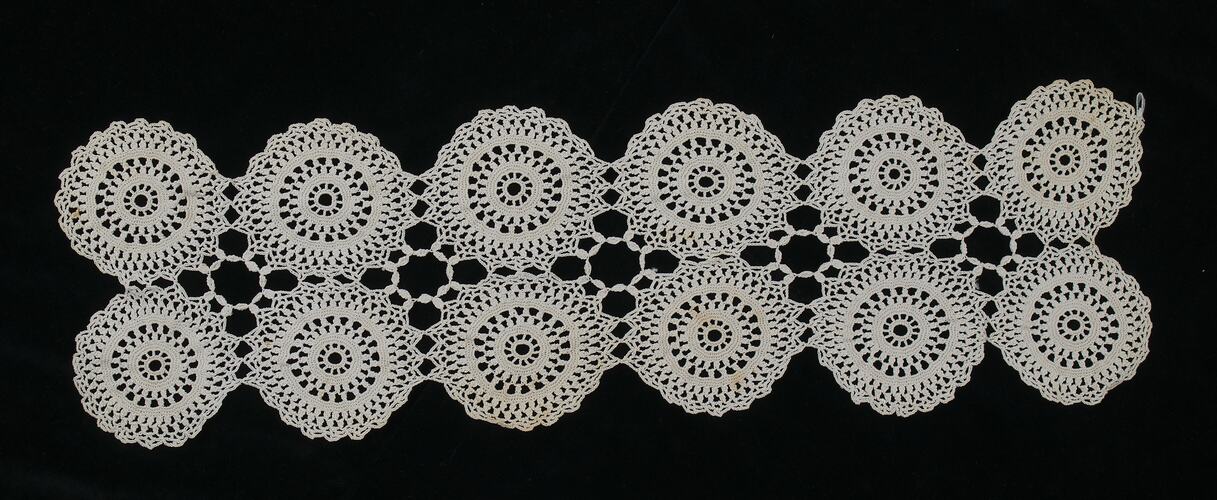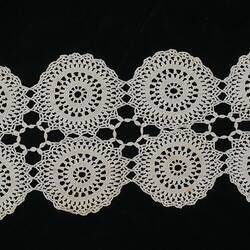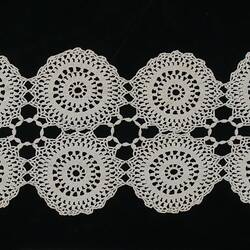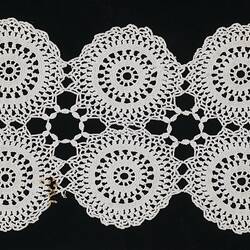Summary
Alternative Name(s): Tablecloth Set, Dressing Table Set
Pair of off-white table cloths, each made from circular pieces of crochet. Made by Elaine Colbert in the 1940s, probably for her glory box. She used one for her bedside table and the other for her chest of drawers; she may have also (or alternatively) used them as a dressing table set. Other contents of Elaine's glory box included bed linen, some given by her aunts, and many items from her mother, including a good knife - her mother 'seemed to have two of everything'.
Elaine was taught handcrafts by her mother, Mina Maba Smith, nee Sullivan. During the Depression, Mina had taken apart her husband's suit and re-made it to save money. She taught Elaine sewing, knitting and crochet, and was president of the mother's club.
Elaine was born in 1926, and attended MacRobertson Girls' High School with her older sister. She wanted to be a nurse, but her father did not allow her that choice. Instead, as she was good at drawing she studied architectural drafting at night at Melbourne Technical College (a three-year course would give university entry to become an architect). Elaine worked during the day as a draftsperson at the Public Works Department, paying her own way through college. She didn't quite finish the three-year course, instead getting married in 1947.
Elaine made handcrafts on the train journey from home in Elsternwick to work. She 'couldn't stand to sit around not occupied'. She gave many pieces away to friends for their glory boxes, and made others especially for her mother.
Physical Description
Pair of off-white table cloths, each made from circular pieces of crochet joined together in two rows to form rectangles. The larger comprises 12 circles; the smaller comprises 6 circles.
Significance
Statement of Significance:
One of several items documenting a post-war Melbourne wedding. The items encapsulate the events and traditions of the time: the bride had accumulated a glory box pre-war and during World War II, making many of the pieces herself. Her dress was made from fabric purchased with coupons from Georges (war-time rationing of clothing was gazetted on 12 June 1942 and removed on 24 June 1948), was designed by herself and was made by her mother's dressmaker.
The significance of this collection is further enhanced by the comprehensive story provided by the bride, who donated the dress, accessories and several textiles from her glory box. She tells of settlement on a poultry farm in Clayton obtained by her husband as an ex-serviceman, of their struggle to make a life there, and of their eventual decision to move to Mornington to raise their family, with her husband working as a public servant. The story also links to the story of her father, who kept meticulous account books documenting the expenditure of his family for over 40 years, also donated to Museum Victoria.
More Information
-
Collecting Areas
-
Acquisition Information
Donation from Mrs Elaine H. Colbert, 31 Aug 2010
-
Maker
Mrs Elaine Colbert nee Smith, Elsternwick, Greater Melbourne, Victoria, Australia, 1940-1949
-
Inscriptions
None.
-
Classification
-
Category
-
Discipline
-
Type of item
-
Overall Dimensions
663 mm (Length), 200 mm (Width)
Larger of two pieces in the set.
-
Overall Dimensions
325 mm (Length), 205 mm (Width)
Smaller of two pieces in the set.
-
Keywords
Glory Boxes, Handcrafts, Marriage Customs & Rites, World War II, 1939-1945





